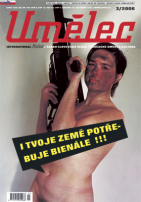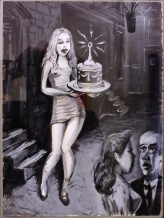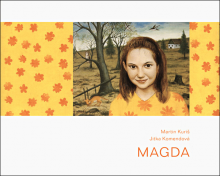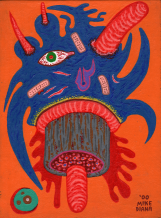| Umělec magazine 2006/3 >> Periferic Biennial. Commonopoly in the artscene | List of all editions. | ||||||||||||
|
|||||||||||||
Periferic Biennial. Commonopoly in the artsceneUmělec magazine 2006/301.03.2006 TELL_1_VISION (Viviana Druga & Tiberiu Bleoanca) | reviews | en cs de |
|||||||||||||
|
The business. The pleasure.
From outside the Romanian art scene, one could observe that the country benefits from a developed art infrastructure similar to that of any Western country. There are specialized galleries, a Museum of Contemporary Art (MNAC), some festivals, 3 important art magazines (Idea, arts + society, Cluj-Napoca; Pavilion magazine, Bucharest and Vector magazine, Iasi) and no less than 3 international biennials (Periferic Biennial, Iasi run by Vector Association; Young Artists’ Biennial, Bucharest run by the Meta Cultural Foundation and Bucharest Biennale run by Artphoto Association). Romania, a post communist country in which the whole art scene doesn’t sum up to more than 100 involved persons and I doubt many people even know what a biennial is, has 3 biennials in the same year : Periferic 7, Young Artists’ Biennial 2 and BB2. Interestingly, two of the mentioned events have no real corresponding numbers according to the editions organized under the adopted BIENNIAL/BIENNALE format. Periferic used to function as a performance festival from 1997 till 2003 when it suddenly metamorphosed into a biennial (nr. 6) with an appointed curator, and the 2nd edition of the Bucharest Biennale has grown from the status of a festival (Artphoto Image Festival 2005) to that of a biennale in just one year (2005-2006). No one has the patience to label an event beginning with its first edition. The transitory conditions of a country, which gets rid of old values without asking itself why and borrows new and more interesting values without discussion, can also be reflected on the art scene. The rush to be part of a bigger organism (Europe), makes us accept with tractability all the provisions stipulated in the contact. The hunger for shiny wrappings makes us determined to construct cultural supermarkets on the Western model. In order to increase the value of a product/event in the art world, you have to label it with the most convincing name: biennial. This way your ‘product’ has plenty of the chances to be internationally remarkable and to sell itself to a certain number of sponsors without which it couldn’t even build its scaffolding. “[…] in the dark period of the 1990s, when the socio-political situation in Romania was still uncertain, the Periferic Project gradually evolved towards a format that would include contemporary art exhibitions. This was done with a view towards creating an audience and participating in the maturation of an artistic scene in Iasi” (Matei Bejenaru, extract from Periferic 7- Focussing Iasi statement). During the “dark period” of the ‘90s whose only light came from the SOROS Foundation’s initiative to give financial support for developing Eastern European art scenes, there were no ideas floating around about legally obtaining sponsorships. SOROS came like a flickering angel (actually a benevolent billionaire), whose mechanism for generating sources of financing nobody could grasp. In that particular period all the events were low-budget performance festivals (Periferic Performance Festival, ZONA Timisoara, The Festival of Saint Ana Lake), sustained mainly by the enthusiasm of the involved people. Back then they worked in a Wild-Wild-East, no art institutions were present and the artistic community got along really well. A real race to extract the “gold” from The European Cultural Foundation, Europe 2000 or Pro Helvetia took place between the fragmented local art scenes. The schism between the local communities’ artistic interests is due to this race. We can still ask ourselves, is it worth organizing another biennial within the international circuit of biennials, in a time when everywhere in the world this kind of events are criticized for their obsolescence, consumer character, political and economic interests and their lack of artistic engagement? Is the more flexible format of a lower budget festival, which doesn’t consume itself so rapidly and still builds something enduring, a paradox? In this respect Periferic Biennial 7, Focusing Lasi, tried to extend the formal display of the exhibition. This was a result of a series of before run conferences where the local socio-political context of Lasi was debated. The preparation process of the whole event was fixed for 2005 but it had to be prolonged one year so all the preliminary research visits of curators and artists to take place. Most works in Lasi were accomplished as a result of contemplation of their regional context. The whole project of Focusing Iasi was developed on a highly-theoretical platform divided into three independent curatorial segments: Social processes, curated by Marius Babias and Angelika Nollert (Turkish Bath), Strategies of Learning curated by Florence Derieux (Cupola Gallery, Museum of Natural Sciences, Palace of Culture) and Why Children? Curated by Attila Tordai-S.(“George Enescu” Arts University - Sports Hall, Goethe Zentrum, Public Spaces and Highschools). All three sections offered source-books which supported and completed the theoretical work of the exhibited pieces. The name of Babias’s section “Social Processes” is imported from Sociology and designates the fact that art can erupt from social processes and can also generate social processes. The artworks in situ included in the Turkish Bath were a sort of cartography of socio-cultural contexts. They look more like a stenograph of a sociological study. Most of the works deal with the issue of globalization and the personal interferences caused by it (Andrea Faciu, Black on White & Vice Versa, Nicoleta Esinescu, Tap-Tarap, John Miller The Middle of the Day, Lia Perjovschi Timeline). Babias operates like a surgeon on the body of globalization, always using politically correct utensils. Unfortunatly his macro lens goes too near its object and risks breaking the shape into millions of pixels. Although the theoretical support of the exhibited works is faultless, it’s almost impossible for the viewer to compose an image out of the dispelled pixels. A computer is needed in order to fulfill this job. When in the exhibition room, you need to take distance in order to obtain a holistic view. We consider two projects to be central to this particular curatorial segment: Dan Perjovschi’s Big Romanian Graffiti and the contribution of H.arta, a Romanian collective of female artists. As usual Perjovschi, with his self-proclaimed “naked drawings,” didn’t take us by surprise and performed again as a barometer of differences between Eastern vs. Western culture... or the lack there of. Sometimes you find yourself laughing alone in the corners of the Turkish Bath at the good quality black humour of the drawings. H.arta’s project About Art and the Ways We Look at the World reacted well against the deficient Romanian educational system, whose art history ends with The Modernist period. H.arta offers an alternative manual to be taught in art universities, a methodological study of art and the ways for looking at it. From the three curators involved in the Periferic project, two of them know the situation in Romania fairly well (M. Babias is of Romanian origin but resides in Berlin, A. Tordai lives and works in Romania ). The third one, F. Derieux comes from totally outside the Romanian context. In distinction to other curators, who have one-week to investigate the regional context, but would never understand it exhaustively, Florence Deriuex, admits being unacquainted and develops the whole project as a “Strategy of Learning,” taking herself as an exponent of the viewer trying to understand the space. In this sense she appeals to international artists who at a certain point interfered with Romanian space. The works, eventually realized in Romania, were never exhibited here. In a “peripheral” city, like Lasi, where local and national myths still persist and irrelevant names of universal cultures still have strong resonance here (Stefan cel Mare, a national, sanctified hero, who couldn’t speak Romanian; M. Eminescu, a talented but completely out of the time Romantic), F. Derieux introduces in her project Andrei Ujica, an almost unknown name on the Romanian scene, but who is placed by Western culture places in Virilio & Baudrillard’s gang. Just like his self-exiled co-national, Tristan Tara (trist= sad; tara= country), who left because he was too sad in his country, A. Ujica uses a “language code” which can be viewed in Romania only 14 years after it was created. Ujica’s Videograms of a Revolution should be introduced as a strategy of re-learning the history of Romania from a mediological point of view ("Mediology describes the mediations, [the system] through which an idea or visual representation becomes a material force." Regis Debray). If we understand repetition as a method of learning, F. Derieux introduces artists, whose understanding is based on the use of the keyword “simulation” associated with “duplication”. This duplicate can be found in the artworks of Pierre Joseph, Sean Snyder and Mathias Olofsson. Joseph’s Trickster Theory in which a 3D character Annlee talks about the communitary subject, a theory belonging to a young philosopher Medhi Belhaj Kacem. The same idea of reality transposed into the virtual space which comes back to the real space remodeling it, can be found also in Sean Snyder’s Dallas Southfork in Hermes Land. The Hermesland in Slobozia is a simulacrum of a simulacrum. It simulates the original film-set in Texas, a simulacrum by nature. At the same time the copy in Slobozia is 20% larger than the original. When they reproduced the ranch they reproduced also the trompe l’oeil. Mathias Olofsson disguises himself in the three pictures (Hidden behind Beauty), placed in Storstina Museum of Natural Sciences as Stor-Stina, the giant freak of nature. In the age of mixing and remixing, the confusion between copy and original, between real and simulation of the real is revealed. The third section of the biennial, Why children?, curated by A. Torday uses spaces (The Sports Hall, The Radio of the school, bars ) that enable interaction with the public. The works of Mircea Cantor Ping Pang Pong and Big Hope’s Commonopoly are constructed like games. The Ping Pang Pong table, a traditional Ping Pong table but with one additional net, is an attempt to learn through games, a way of learning to readapt to the new conditions in the contemporary society. It was organized as a school championship, a metaphorical social experiment introduced in the school, a space of practice and exercise. Initially the project was conceived to penetrate even further into the public space, but because of financial reasons some artistic productions had to be restricted to a sample display. For example Nedko Solakov’s A Salvaging-Your-Future-Life-From-Unnecessary-Good-Citizen-Feelings Children Toys Kit consists of toys with the instrument for their destruction attached. Initially it was intended that these assemblages would be serialized and launched on the market and introduced into toy shops. Solakov’s toys are the perfect capitalist product. The product is programmed to have a short life, encouraging the never-ending buying of another one and then another one in order to accelerate the consumption process. An interesting point of view is the play with the words monopoly and common in the Commonopoly of Big Hope group. As opposed to Monopoly which deals with ownership and property rights, Commonopoly is concerned with property lefts, about sharing and offering, about goods and services which cannot be taken into possession. If this experimental model of social coexistence could be successfully applied in the Romanian art scene, it would mean the successful reconciliation of the business and pleasure involved in each institution of the art scene. PLAY NICE KIDS!
01.03.2006
Recommended articles
|
|||||||||||||
|
04.02.2020 10:17
Letošní 50. ročník Art Basel přilákal celkem 93 000 návštěvníků a sběratelů z 80 zemí světa. 290 prémiových galerií představilo umělecká díla od počátku 20. století až po současnost. Hlavní sektor přehlídky, tradičně v prvním patře výstavního prostoru, představil 232 předních galerií z celého světa nabízející umění nejvyšší kvality. Veletrh ukázal vzestupný trend prodeje prostřednictvím galerií jak soukromým sbírkám, tak i institucím. Kromě hlavního veletrhu stály za návštěvu i ty přidružené: Volta, Liste a Photo Basel, k tomu doprovodné programy a výstavy v místních institucích, které kvalitou daleko přesahují hranice města tj. Kunsthalle Basel, Kunstmuseum, Tinguely muzeum nebo Fondation Beyeler.
|

































 New book by I.M.Jirous in English at our online bookshop.
New book by I.M.Jirous in English at our online bookshop.
Comments
There are currently no comments.Add new comment